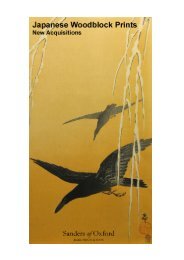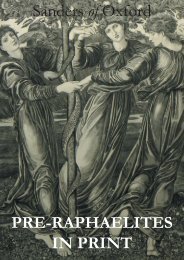You also want an ePaper? Increase the reach of your titles
YUMPU automatically turns print PDFs into web optimized ePapers that Google loves.
48. Anonymous Photographer<br />
Gaicha de Yokohama<br />
Date [Western]: ca. 1875-78<br />
Date [Japanese]: Meiji period<br />
Method: Hand-tinted albumen print<br />
Dimensions: 8 x 5 3/4 inches<br />
Condition: Slight, restored tear in lower centre<br />
Code: AD33<br />
Price [Framed]: £190<br />
One <strong>of</strong> two photographs in the exhibition from a nineteenth-century French album [see also,<br />
Cat. No. 49, below], this depicts a geisha and a maiko, probably sisters from the same okiya,<br />
in a tatami-matted room, re-enacting the preparations for a zashiki [‘a banquet room’; used<br />
as a term for an engagement]. The kneeling geisha is assisting her onêsan in tying her heavy<br />
obi [sash].<br />
During the Edo period, while the form <strong>of</strong> the kimono scarcely changed, the obi appeared in a<br />
variety <strong>of</strong> ties and widths, marking trends in fashion and denoting one’s place in both fixed<br />
and floating world hierarchies. It appears that the weave evolved as well, shifting in around<br />
1800, from the pliant fabric evident in prints by, for example, Harunobu (ca.1724-1770), to<br />
the stiff, elaborate, ‘tapestry’ cloth favoured by Kunisada’s bjin [see, for example, Cat. No.:<br />
1-3]. From this point onwards, it came to dominate a woman’s ensemble, so much so that, as<br />
Dalby [1983: p.297] puts it ‘the kimono [became] merely a backdrop for the obi.’<br />
Thus, for the contemporary art historian, the pattern, colour and arrangement <strong>of</strong> the obi is<br />
one <strong>of</strong> the key iconographical elements used in determining the societal and pr<strong>of</strong>essional<br />
positioning <strong>of</strong> its wearer. High-ranking yûjo characteristically tied their obi at the front in the<br />
style <strong>of</strong> married women, to visually suggest that they were ‘married’ to their clients for the<br />
night. The less salubrious explanation being that having the unwieldy obi front-tied,<br />
facilitated expeditious dressing and undressing.<br />
49. Anonymous Photographer<br />
Kamisan de Tokio<br />
Date [Western]: ca. 1875-78<br />
Date [Japanese]: ca. Meiji 8-11<br />
Method: Albumen print<br />
Dimensions: 7 3/4 x 5 1/4 inches<br />
Code: AD34<br />
Price [Framed]: £400<br />
An extremely rare portrait study <strong>of</strong> a Okami-san or mistress <strong>of</strong> an ochaya [teahouse],<br />
wearing a formal black five-crested tomesode. Okami-san were retired geisha who, although<br />
still occasionally attending banquets, performing and entertaining clients, presided over the<br />
complex administration <strong>of</strong> the flower and willow world.<br />
In the latter half <strong>of</strong> the nineteenth century, the most famous and exclusive hanamachi in<br />
Tôkyô were located in Shimbashi and Asakusa. The former, in particular, being a nerve<br />
centre for the increasingly influential militarists in the Meiji government ~ their celebrations<br />
and parties played out within the teahouses <strong>of</strong> the quarter. Thus, the ostensibly dowdy and<br />
commonplace okamisan depicted in this unusually intimate photograph, would have been<br />
privy to, and in some respects orchestrated, some <strong>of</strong> the most important political gatherings<br />
<strong>of</strong> the age.<br />
50. Anonymous Japanese Photographer<br />
A Study <strong>of</strong> a Maiko in an Garden<br />
Date [Western]: ca. 1880s<br />
Date [Japanese]: Meiji period<br />
Method: Albumen print












